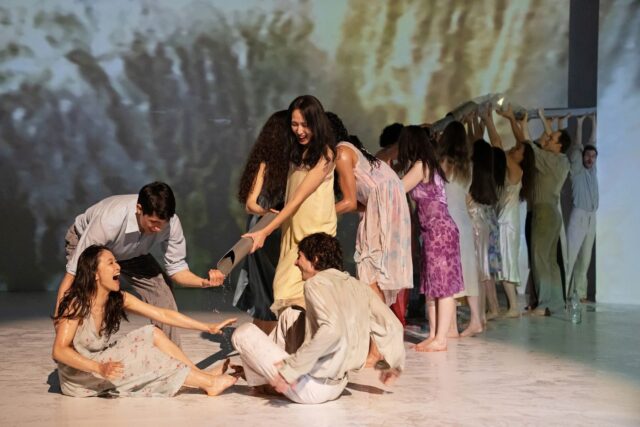
Performers enjoy a drink of water in Pina Bausch’s Água at BAM (photo by Julieta Cervantes)
ÁGUA
BAM Howard Gilman Opera House, Peter Jay Sharp Building
230 Lafayette Ave. between St. Felix St. & Ashland Pl.
March 3-19
www.bam.org
www.pina-bausch.de/en
Dance-theater pioneer Pina Bausch would probably agree with Nobel Prize–winning Hungarian biochemist Dr. Albert Szent-Györgyi, who said “Water is life’s matter and matrix, mother and medium. There is no life without water.”
In such dazzling pieces as Vollmond (Full Moon), Nefés, and “…como el musguito en la piedra, ay si, si, si…” (Like moss on a stone), Bausch repeatedly explored the role of this element, the elixir of life.
Water again takes center stage in the US premiere of Tanztheater Wuppertal Pina Bausch’s Brazil-inspired Água, which debuted in 2001 in Rio de Janeiro and has at last come to BAM, the company’s exclusive New York home since 1984. Água, which means “water,” is a nearly three-hour masterpiece (with a far too long intermission), combining music, comedy, storytelling, video, props, and, of course, sensational dance. Peter Pabst’s stark white stage features three large curved screens on which he projects footage of palm trees blowing in the wind, a team of drummers playing in the street, and adventures through the rainforest.
Men in everyday clothing and suits and women in gorgeous, colorful gowns — Marion Cito’s costumes are stunning — perform a series of vignettes to songs by a wide range of artists, including Mickey Hart, Tom Waits, the Tiger Lillies, PJ Harvey, Amon Tobin, Susana Baca, Caetano Veloso, David Byrne, Gilberto Gil, Bebel Gilberto, Nana Vasconcelos, and Antonio Carlos Jobim.
Tsai-Wei Tien is lifted off the ground and passed hand to hand by Dean Biosca, Oleg Stepanov, and Denis Klimuk, clad only in bathing suits and platform shoes, Christopher Tandy rows across the stage in a palm leaf, Tsai-Chin Yu asks several people in the first row where they are from and then uses a boot to predict the weather there, and a dancer in a lush red dress falls to the ground and reveals her long legs as men pass by, ignoring her. Performers break out into sudden solos that meld with the projected images that envelop them. The screens rise to reveal a surprise behind them. The women all have long hair that they use inventively as an object of sex and power.
Fire plays a continuing function, as dancers light cigarettes and candles and original Água cast member Julie Shanahan tries to set the place ablaze, explaining, “I wanted to do something really beautiful for you, but I don’t know how. . . . I wanted to go crazy. But it’s not possible.” The cast, which also features Emma Barrowman, Naomi Brito, Maria Giovanna Delle Donne, Taylor Drury, Letizia Galloni, Nayoung Kim, Reginald Lefebvre, Alexander López Guerra, Nicholas Losada, Jan Möllmer, Milan Nowoitnick Kampfer, Franko Schmidt, Ekaterina Shushakova, Julian Stierle, and Sara Valenti, attends a cocktail party, pulls out white couches to take a break, and uses hilariously patterned towels at a beach resort. They bounce off walls. They spray water at each other. They use microphones as if they’re comedians.
A handful of scenes feel extraneous, and Bausch’s highly gendered choreography can be perceived as out of date in 2023, though the company has its first trans dancer (Brito). But Água is still hugely entertaining.
Bausch, who died in June 2009 at the age of sixty-eight, displayed a passion for life and all that it offers in her work, from light to dark, creating a mélange that ranged from Café Müller and The Rite of Spring to Kontakthof and Bamboo Blues. Artistic director Boris Charmatz continues her legacy with this international tour of Água, which is, contrary to what Shanahan said, “something really beautiful.”